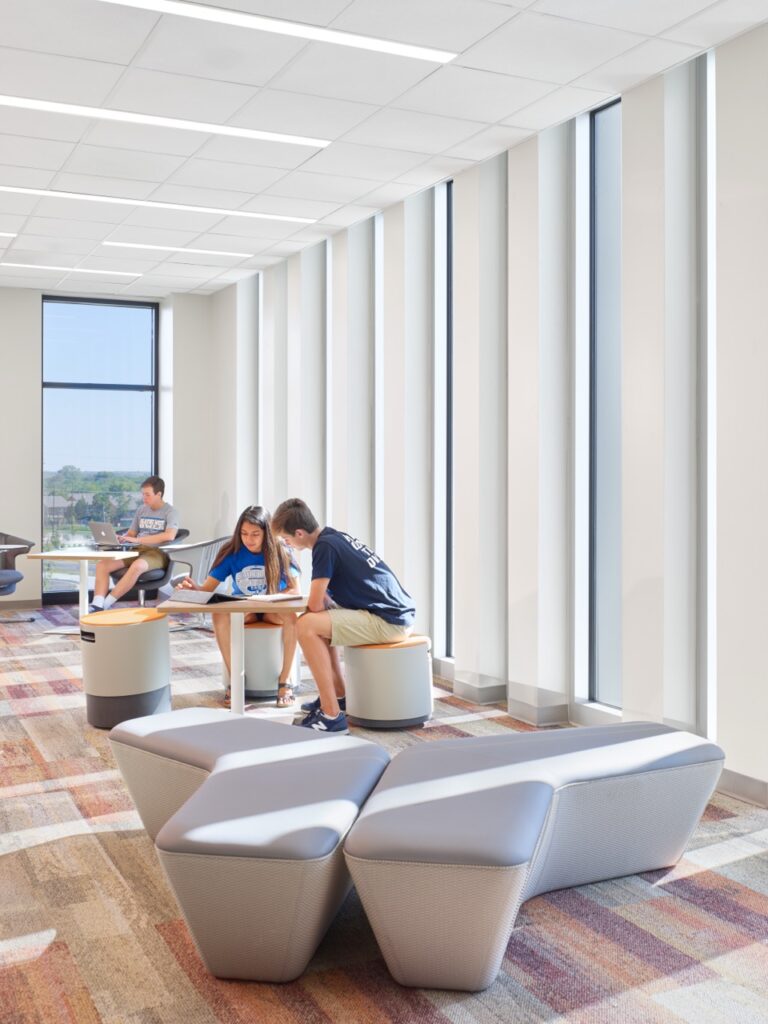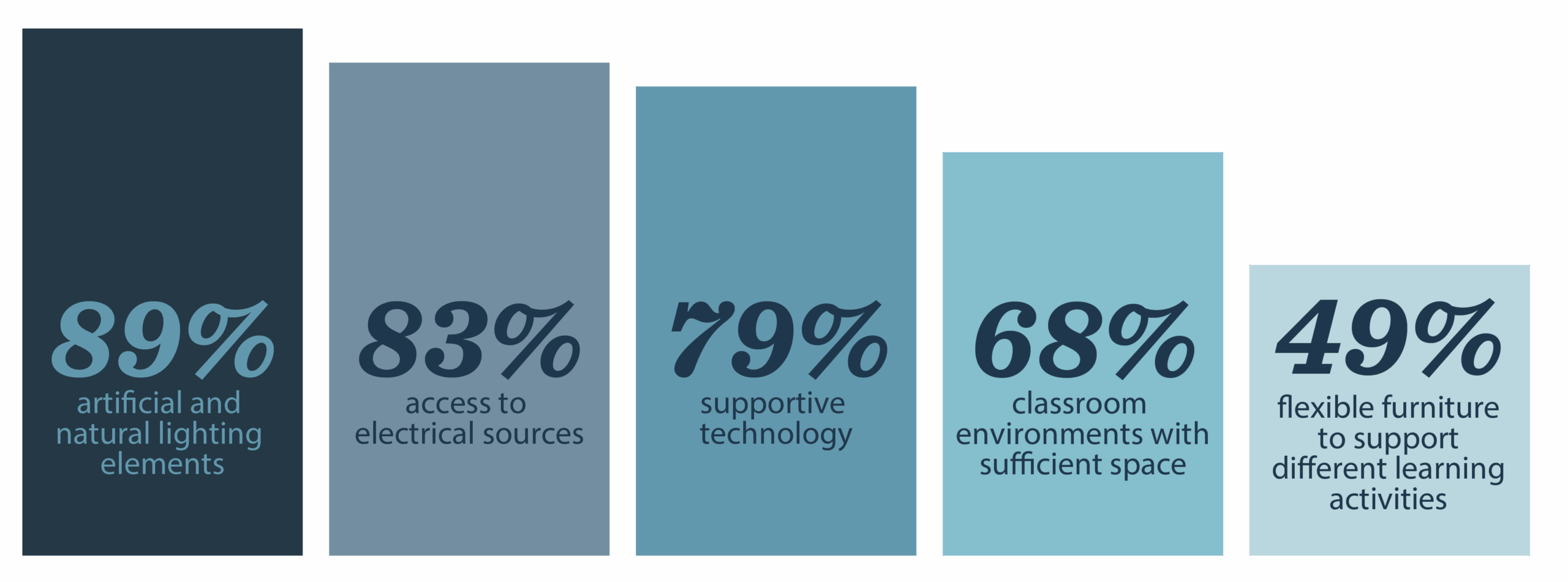 For decades, public schools in the U.S. have faced teacher shortages and the related challenges of effectively recruiting and retaining high-quality staff. This is a complex issue occurring at the nexus of various economic, social, and cultural trends. As a design firm, we are interested in how the built environment might play a role in this multifaceted problem. While it may be only one piece in the vast puzzle, research shows the built environment can play both a direct and indirect role in teacher recruitment and retention. While there is evidence to suggest that facility condition itself can be a contributing factor to teachers’ decisions to join or stay at a school2,3, the facility may also have indirect influences on teachers’ experiences and decision calculus as they consider whether to stay in their current position or within the profession more generally.
For decades, public schools in the U.S. have faced teacher shortages and the related challenges of effectively recruiting and retaining high-quality staff. This is a complex issue occurring at the nexus of various economic, social, and cultural trends. As a design firm, we are interested in how the built environment might play a role in this multifaceted problem. While it may be only one piece in the vast puzzle, research shows the built environment can play both a direct and indirect role in teacher recruitment and retention. While there is evidence to suggest that facility condition itself can be a contributing factor to teachers’ decisions to join or stay at a school2,3, the facility may also have indirect influences on teachers’ experiences and decision calculus as they consider whether to stay in their current position or within the profession more generally.
In numerous studies, researchers find that teacher retention is impacted by factors within the classroom, including student performance, especially relating to behavior and academic achievement2,3,5. Student performance is a complex issue itself, mediated by various factors including the quality of the learning facility. Research shows that when students attend school in a healthy environment, they benefit not only from improved health outcomes, but from improved cognitive function, ultimately leading to better performance6,7,8,9. Across numerous studies, facility performance has accounted for between 10-16% of variance in student test scores9. Elements like air quality, acoustic quality, and access to natural light have been correlated with student performance in multiple academic areas.
The amount of windows make the school so much better, it’s brighter and more open which I believe promotes kids productivity by allowing them to see the sun and gain Vitamin D. This in turn promotes students’ morale and happiness.
11th-grade student
Beyond the basic components of a healthy building, students may see additional impacts on their performance. Students who attend schools featuring innovative design elements (e.g., open classroom spaces and instructional neighborhoods) benefit from various aspects of improved well-being and academic performance. While these effects are likely mediated by the instructional approaches taken within the spaces6, studies have found them to be correlated with improved test scores8,9,10 and engagement11,12, and even lower rates of bullying13.
Various aspects of a school’s organizational environment and teacher working conditions have also been linked to teacher retention. Scholarship has helped to identify the importance of transformational leadership and a collaborative teaching environment in promoting teacher retention2,3,4. In recent post-occupancy surveys of schools with at least one dedicated teacher workroom, 41% of educators report collaborating with their colleagues more often in their new facility than in previous ones. This demonstrates how, along with supportive leadership, aspects of the facility design can contribute to a shift in staff behavior and organizational culture.
The Consortium on Chicago School Research finds that the factors that most strongly predict teacher stability are related to the degree of control teachers have3. In long-range planning surveys, staff members often report challenges with aspects of their environment that prohibit them from performing their job to its full extent. Meanwhile, in post-occupancy surveys, teachers often report success relating to many of the same elements, demonstrating how a facility can provide teachers control over their physical work environment.
Recent surveys reveal notable success in providing teachers control over their work environment through artificial and natural lighting elements, access to electrical sources and supportive technology, and classroom environments with sufficient space and furniture that can be easily rearranged to support different learning activities.

Among the various factors contributing to current trends in teacher retention are both direct and indirect influences of facility conditions. The influences of school climate and student performance are well reported in the literature, but the impact of the built environment on these factors is less commonly discussed. Research shows how the conditions of a facility can have an impact on student behavior and achievement, as well as staff culture and climate, which in turn may influence teacher retention in those facilities.

Research Support
Share this post:
References
1: Anglum, J.C. (2025). Teacher turnover: Pre-and post-pandemic trends in Missouri. Policy Research in Missouri Education, 7(14). Saint Louis University. www.primecenter.org/education-reprorts-database/teacher-turnover
2: Ladd, H. F. (2011). Teachers’ perceptions of their working conditions: How predictive of planned and actual teacher movement? Educational Evaluation and Policy Analysis, 33(2), 235-261.
3: Consortium on Chicago School Research. (2009). The schools teachers leave: Teacher mobility in Chicago Public Schools. https://consortium.uchicago.edu/sites/default/files/2023-06/The%20Schools%20Teachers%20Leave-Jun2009-Consortium.pdf
4: Podolsky, A., Kini, T., Bishop, J., & Darling-Hammond, L. (2017). Sticky schools: How to find and keep teachers in the classroom. The Phi Delta Kappan, 98(8), 19-25.
5: National Clearinghouse for Educational Facilities. (2004). The effects of school quality on teacher retention in urban school districts. https://files.eric.ed.gov/fulltext/ED539484.pdf
6: Woolner, P., Hall, E., Higgins, S., McCaughey, C., & Wall, K. (2007). A sound foundation? What we know about the impact of environments on learning and the implications for building schools for the future. Oxford Review of Education, 33(1), 47-70.
7: Leiringer, R. & Cardellino, P. (2011). Schools for the twenty-first century: School design and educational transformation. British Educational Research Journal, 37(6), 915-934.
8: Tanner, C. K. (2009). Effects of school design on student outcomes. Journal of Educational Administration, 47(3), 381-399.
9: Byers, T., Mahat, M., Liu, K., Knock, A., & Imms, W. (2018). Systematic Review of the Effects of Environments on Student Learning Outcomes. Melbourne: University of Melbourme, LEaRN. Retrieved from: http://www.iletc.com.au/publications/reports
10: Brooks, C. (2011). Space matters: The impact of formal learning environments on student learning. British Journal of Educational Technology, 42(5), 719-726.
11: Oliveras-Ortiz, Y., Bouillion, D. E., & Asbury, L. (2019). Listening to high school students: Purposefully designed spaces and the impact on students’ engagement in learning. Educational Leadership and Policy Studies Faculty Publications and Presentations. Paper 27.
12: Scott-Webber, L., Konyndyk, R., French, R., & French, J. (2018). Significant results: Space makes a difference increasing student academic engagement levels. European Scientific Journal, 14(16), 61-84.
13: Samara, M., & Smith, P. (2020). School design, climate and safety: Strategies for anti-bullying interventions and inclusiveness. International Journal of Emotional Education, 12(2).